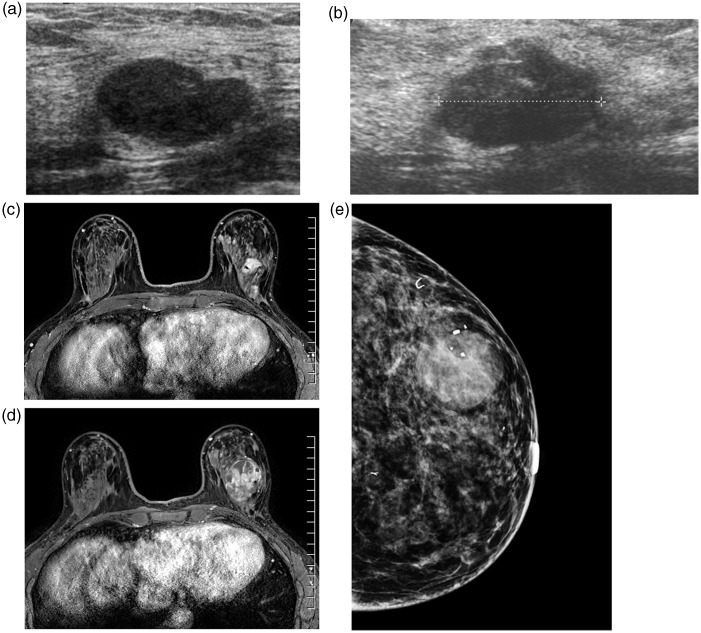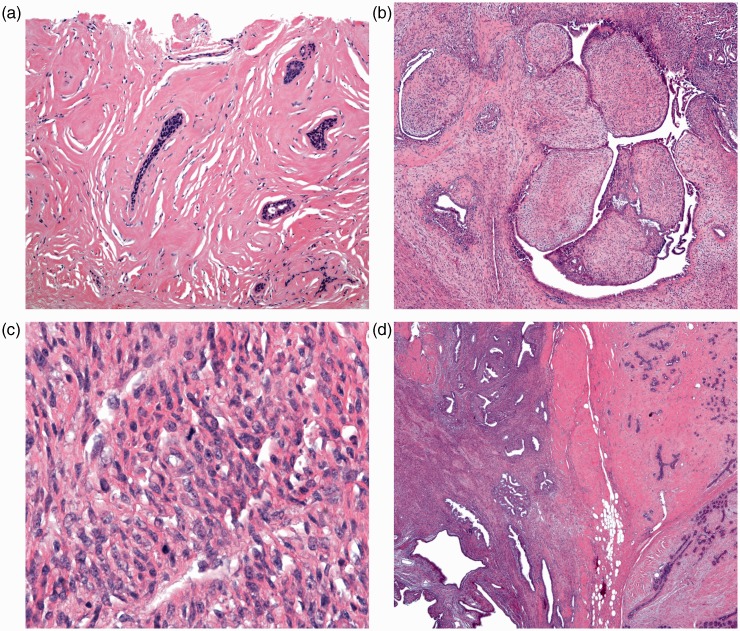Abstract
The transformation of a benign fibroadenoma into a phyllodes tumor is uncommon and unpredictable. We report the case of a 40-year-old woman with a core biopsy proven fibroadenoma that underwent transformation into a malignant phyllodes tumor after 3 years of size stability. We present ultrasound and magnetic resonance images, as well as pathology slides from core biopsy and surgical excision, to illustrate this transformation. It has been suggested that phyllodes tumors may be misdiagnosed as fibroadenomas by core biopsy. However, in this case, pathology supports correct initial diagnosis of fibroadenoma and demonstrates a portion of the original fibroadenoma along the periphery of the malignant phyllodes tumor.
Keywords: Phyllodes tumor, fibroadenoma, malignant transformation, breast, magnetic resonance imaging (MRI)
Introduction
There are two possibilities that could account for a core-biopsy proven fibroadenoma being re-diagnosed as a phyllodes tumor. The first possibility is misdiagnosis at core biopsy due to their overlapping pathologic appearance. The second possibility is more interesting, and relates to the transformation of a fibroadenoma into a phyllodes tumor. This transformation has been well-documented in the pathology, surgical, and radiological literature; however, there is a paucity of radiologic images demonstrating this process, in particular, magnetic resonance imaging (MRI).
Case report
A 40-year-old woman with a history of prior biopsy of a benign fibroadenoma (FA) presented for routine screening mammogram and breast ultrasound. On screening ultrasound, a new 1.8 cm hypoechoic lesion was visualized in the lateral left breast (Fig. 1a). Subsequent ultrasound-guided biopsy revealed another benign FA. This FA remained stable in size and appearance both mammographically and sonographically over the next 3 years (Fig. 1b). Breast MRI (performed on Philipps Achieve 1.5 T magnet, with T1, T2 sequences, fat suppressed dynamic sequences following i.v. gadolinium by patient weight) ordered for high-risk screening within this 3-year time interval demonstrated a 1.8 cm well-circumscribed, mostly T2 hyperintense, enhancing lesion containing a biopsy clip in the lateral left breast (Fig. 1c).
Fig. 1.
(a) A 40-year-old woman. US image at the time of initial core biopsy demonstrates a 1.8 cm well-circumscribed, hypoechoic lesion, consistent with a fibroadenoma. (b) Three years later, the FA is stable in size, but shows slight heterogeneity and is not as well circumscribed. (c) Fat-suppressed dynamic-enhanced MR image performed at the time of second ultrasound shows a 1.8 cm well-circumscribed, enhancing nodule. (d) Fat-suppressed dynamic-enhanced MR image 1 year after the previous MRI shows a heterogeneously enhancing mass that has doubled in size. (e) Left CC mammogram at the time of diagnosis of malignant phyllodes tumor shows a dominant mass with biopsy marker clip. Other marker clips are present in additional previously biopsied stable fibroadenomas.
The patient returned for her routine annual screening mammogram and breast ultrasound 4 years after the initial biopsy. The lesion in question (biopsy proven FA) was noted to have doubled in size. The possibility of transformation into PT was raised and excision suggested. On preoperative contrast-enhanced MRI, the mass had increased in size to 4 cm with heterogeneous enhancement and new cystic changes (Fig. 1d). The mass was surgically excised and final pathologic diagnosis was high-grade malignant PT.
Discussion
To our knowledge, this is the first MR imaging case report demonstrating the malignant transformation of a core biopsy proven FA, which occurred after 3 years of size stability. Like FAs, PTs are biphasic neoplasms composed of epithelial elements and connective tissue stroma. Compared to FAs, PTs have higher stromal cellularity and a greater propensity for rapid growth. PTs are much less common than FAs, accounting for less than 1% of all breast tumors. The high-grade malignant subtype represents 25–30% of resected PTs. Studies using genetic clonal analysis have shown that a FA can transform into a benign or malignant PT (1,2). No clinical or imaging findings have been identified to reliably distinguish FAs from PTs, or to distinguish benign from malignant PTs. However, transformation to PT should be considered if there is rapid growth of a documented and previously stable FA (3).
It has been suggested that PTs may be misdiagnosed as FAs by core biopsy. However, in this case, pathology supports correct initial diagnosis of FA (Fig. 2a). In addition, pathology of the excised lesion (Fig 2b and c) demonstrates a portion of the original FA along the periphery of the malignant PT (Fig. 2d).
Fig. 2.
(a) Benign fibroadenoma with characteristic collagenous stroma and distorted, slit-like elongated ducts (10×, H&E). (b) Malignant phyllodes tumor with classic leaf-like epithelial proliferation and increased stromal cellularity (4×, H&E). (c) On higher power, the malignant phyllodes tumor shows marked stromal pleomorphism and increased mitotic activity (20×, H&E). (d) At the periphery of the malignant phyllodes tumor, a portion of the original fibroadenoma is identified (4×, H&E).
A recent review from this institution analyzed 85 growing FAs over a 10-year period, which were re-cored, excised, or underwent follow-up (4). The incidence of epithelial malignancy in these 85 growing lesions was 0%. However, two of the 85 growing FAs were subsequently diagnosed as benign PTs by core/surgical excision. None of the growing FAs in the series were subsequently shown to represent malignant PTs. This current case report is the first documented case at this institution of a growing FA subsequently diagnosed as a malignant PT.
In conclusion, the overwhelming majority of growing FAs are benign, and occasionally a benign PT will be subsequently diagnosed. The transformation to a malignant PT is rare. The 3-year period of stability in this case suggests that the timing of transformation is unpredictable. In addition, there is no accurate imaging or clinical predictor of which lesion will transform. Therefore, no specific follow-up is required for biopsy-proven FAs unless rapid growth signals the possibility of transformation.
Conflict of interest
None declared.
References
- 1.Noguchi S, Yokouchi H, Aihara T, et al. Progression of fibroadenoma to phyllodes tumor demonstrated by clonal analysis. Cancer 1995; 10: 1779–1785. [DOI] [PubMed] [Google Scholar]
- 2.Valdes EK, Boolbol SK, Cohen J-M, et al. Malignant transformation of a breast fibroadenoma to cystosarcoma phyllodes: case report and review of the literature. Am Surg 2005; 71: 348–353. [PubMed] [Google Scholar]
- 3.Abe M, Miyata S, Nishimura S, et al. Malignant transformation of breast fibroadenoma to malignant phyllodes tumor: long-term outcome of 36 malignant phyllodes tumors. Breast Cancer 2011; 18: 268–272. [DOI] [PubMed] [Google Scholar]
- 4.Sanders L, Sara R. The growing fibroadenoma. Acta Radiol Open 2015; 4: 2047981615572273–2047981615572273. [DOI] [PMC free article] [PubMed] [Google Scholar]




